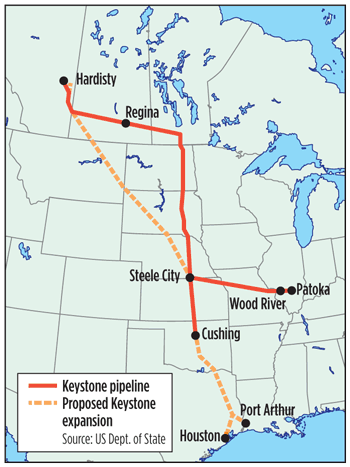|
The proposed expansion of the Keystone pipeline system, which transports synthetic crude oil from the Canadian oil sands into the US, has aroused considerable controversy of late. Keystone XL, as the expansion project is called, has faced lawsuits from oil refineries, criticism from environmentalists and some members of Congress, and civil disobedience leading to mass arrests. Why all the fuss over a pipeline, when the US already has over 360,000 miles of oil and gas pipelines? Pipeline basics. In June 2010, TransCanada commenced operation of Keystone’s first phase from northeastern Alberta to refineries in Illinois. An extension called Keystone Cushing went into service this February, stretching from Steele City, Nebraska, to Cushing, Oklahoma. The proposed XL project is a 1,661-mile, 36-in. crude oil pipeline that would begin at Hardisty, Alberta, and extend southeast through Saskatchewan, Montana, South Dakota and Nebraska, incorporate a portion of Keystone Cushing in Nebraska, Kansas and Oklahoma and then continue to Port Arthur, Texas. The US$5 billion XL pipeline is scheduled to be completed during 2013. The final US State Department environmental impact report, released in August, found that the pipeline would have no significant impacts on most natural resources. The final US government decision, which ultimately rests with President Obama, is expected by the end of the year.* Opposition. Antagonism toward XL has become a cause célèbre among environmentalists. Last December the No Tar Sands Oil campaign was launched, sponsored by activist groups including the Sierra Club, the National Wildlife Federation, Friends of the Earth, Greenpeace and Rainforest Action Network. The US$500,000 campaign includes various protest actions and widely broadcast TV ads encouraging people to urge Obama to stop the pipeline from being built. In August, thousands of protesters picketed and staged sit-ins in front of the White House for over two weeks in opposition to the pipeline. They received enormous publicity and 1,250 were arrested, including actress Darryl Hannah. Organizers are currently planning a second phase of protests. Reality check. Keystone XL will transport up to 830,000 bpd of oil to refineries on the Gulf Coast. Upon completion, the entire Keystone pipeline system would provide 1.1 million bpd—9% of current US imports—significantly improving North American energy security. The XL project will also create about 20,000 US jobs during the construction phase in 2012–2013, which will be a big boost to the dismal economy. In the longer term, a study released in June by the Canadian Energy Research Institute (CERI) predicts increases of C$2.9 trillion and US$349 billion to Canadian and US GDP, respectively, and enhanced long-term job creation in both countries. The opposition contends that oil sands disproportionately contribute to greenhouse gas (GHG) emissions. However, according to recent data from CERI and the Canadian Association of Petroleum Producers, total GHG emissions from oil sands are equivalent to about 5% of Canada’s total emissions, 0.5% of US GHG emissions, and 0.001% of global GHG emissions, and average GHG emissions per bbl in the oil sands industry have decreased by 30% since 1990. Much of the opposition is based on the assumption that, if XL is not built, oil sands will stay in the ground. But Canadians will continue to develop this resource and will simply ship it elsewhere—perhaps to China, according to a recent statement by Foreign Minister John Baird. Perhaps the relevant question for anti-Keystone activists is “Where would you rather see that crude processed: in the US and Canada, both of which have strong environmental regimes, or in China, which does not?” A symbol. In the end, facts may not matter: The XL pipeline has become a symbol and rallying point for environmentalists, their “line in the (oil) sand.” But XL is another kind of symbol as well. The project arose in part due to the growing difficulty of expanding Midwest refining capacity, which can’t keep up with the region’s consumption. Midwest refineries are planning to expand in order to handle more heavy crude from Canada, but major refinery expansion is extremely expensive and subject to intense environmental opposition, and the projects are behind schedule. In fact, over the past several decades it has become increasingly difficult to build any kind of new major energy infrastructure project: pipelines, transmission lines, production facilities, power plants, etc. If the US is ever to get out of its economic morass and confront its looming energy problems, this has to change, and quickly. Approval and expeditious construction of the XL pipeline would be a powerful symbol of such change. WO
*Since the printing of this column, the US State Department has decided to delay its final decision on the Keystone pipeline until 2012. For the story, click here.
|
- Shale technology: Bayesian variable pressure decline-curve analysis for shale gas wells (March 2024)
- Prices and governmental policies combine to stymie Canadian upstream growth (February 2024)
- U.S. producing gas wells increase despite low prices (February 2024)
- U.S. drilling: More of the same expected (February 2024)
- U.S. oil and natural gas production hits record highs (February 2024)
- U.S. upstream muddles along, with an eye toward 2024 (September 2023)
- Applying ultra-deep LWD resistivity technology successfully in a SAGD operation (May 2019)
- Adoption of wireless intelligent completions advances (May 2019)
- Majors double down as takeaway crunch eases (April 2019)
- What’s new in well logging and formation evaluation (April 2019)
- Qualification of a 20,000-psi subsea BOP: A collaborative approach (February 2019)
- ConocoPhillips’ Greg Leveille sees rapid trajectory of technical advancement continuing (February 2019)




